Simplelocker, an android ransomware

Table of Content⌗
Introduction⌗
Samples⌗
samples can be obtained from various android malware repositories. I had the dex one but had to get an apk version from the koodous website.
Environment⌗
- linux host with analysis tools
- android vm (API version 16)
Tools⌗
- bytecodeviewer
- apktool
- androgaurd
- adb
- jd-gui
- enjarify
Dynamic analysis⌗
Before any analysis, I have created some external storages in my VM so we can confirm thisransomware encrypts those files.

Now, we can install the malware on the VM.
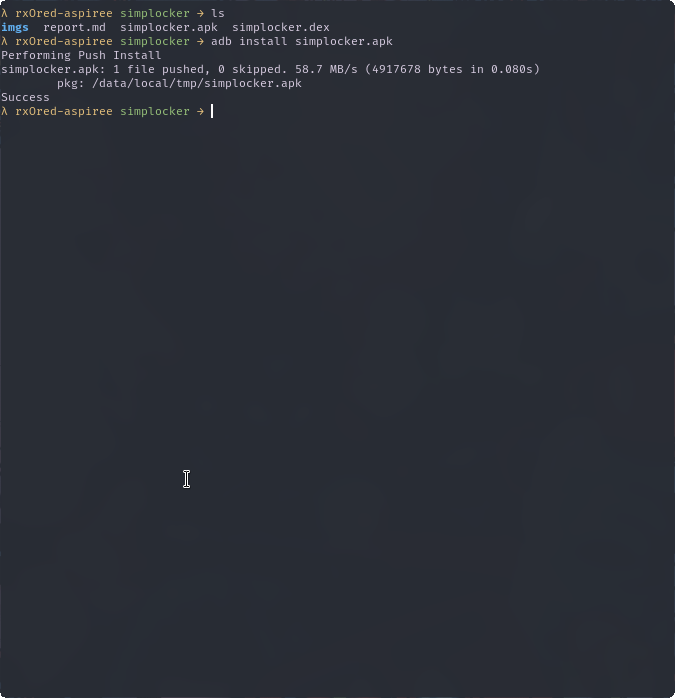

after clicking on the installed malware, we get a prompt which contains some text from a language which i beleive to be alien. :) (nah its probably russian…)

Lets try removing the malware using adb.
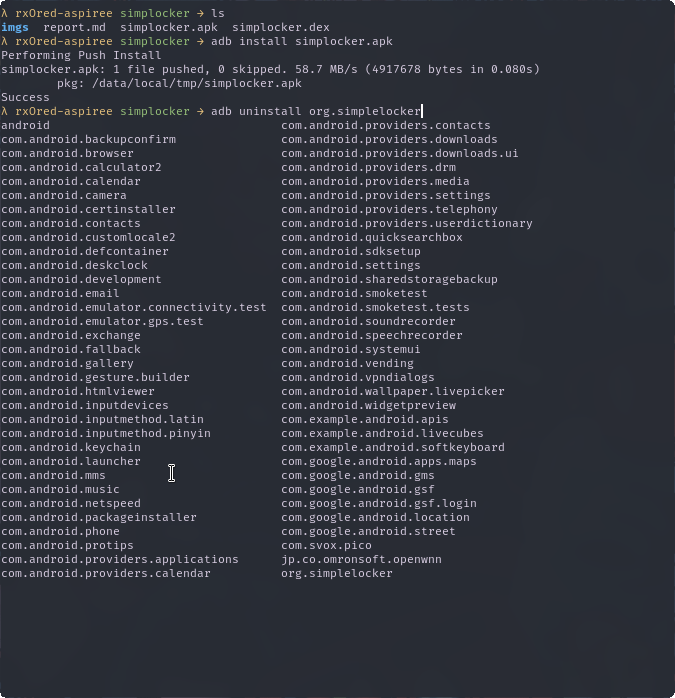
whoaa whoaa? did we just uninstalled the ransomeware? wow. we are sooo cool. no. not really. remember kid. this is a ransomware. it has probably encrypted every damn file on the device. To make sure, lets check the external storages we created earlier.

Static analysis⌗
Decompiling⌗
first, let’s run apktool on the apk and get the smali code.
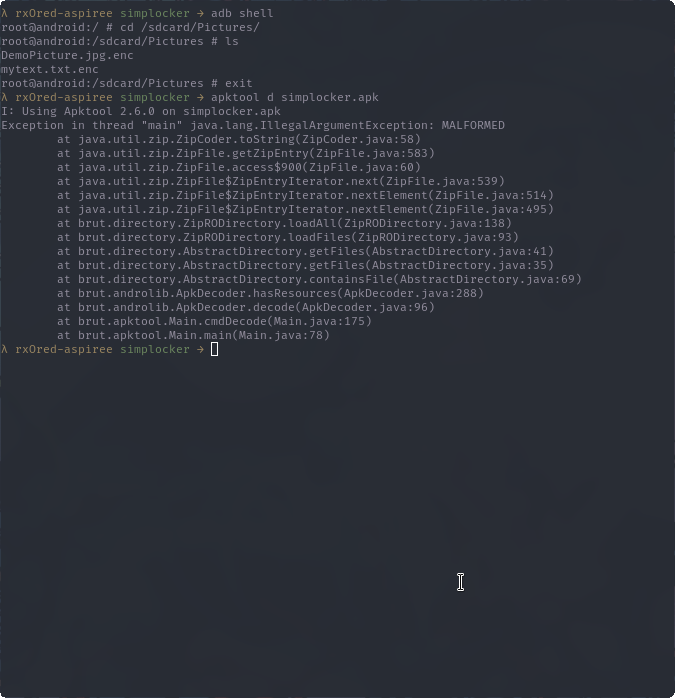
I think the issue is with the charset, cause the app uses some weird alien language which i beleived to be russian. I dont know a specific way to solve this problem so im gonna try updating the tool.
Well it didnt work.
Dont lose your hopes comrad i got a way around this. we can use jd-gui!!! However to do so, we need to convert .apk file to a .jar file.
enjarify is a nice tool to do this. here’s a link to the github repo : https://github.com/google/enjarify.git
λ rxOred-aspiree simplelocker → enjarify simplelocker.apk
Using python3 as Python interpreter
1000 classes processed
2000 classes processed
Output written to simplelocker-enjarify.jar
2693 classes translated successfully, 0 classes had errors
here is the result :)
Now, lets see what jd-gui got for us.
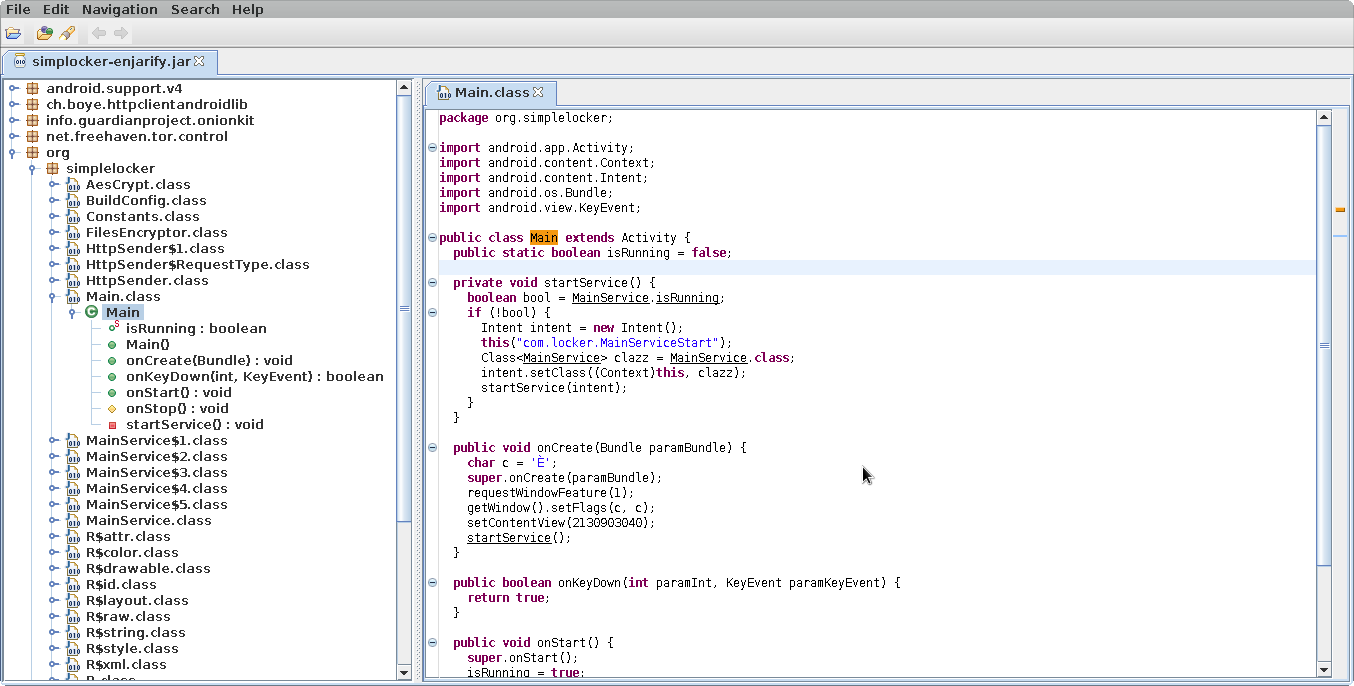
Main⌗
here we can see Main, which i think is the main activity. if you dont know what it is, refer an android development guide.

here we can see a call to requestWindowFeature() function, which is used to exclude or include various window features such as toolbar, actionbar and so on. In this case, i honestly dont know what the parameter means (well yes ik its a constant).
then onCreate invokes setFlags() with E as an argument. then it sets content view to some random looking value.
Then there is a juicy part. it calls startService function, which is used to start a long running service as the name implies.
we can see the definition of that function right above the onCreate().
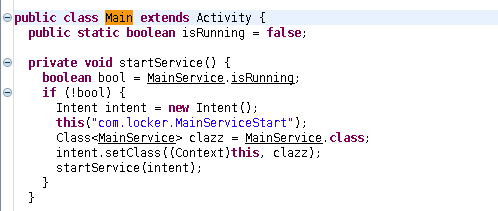
Here it checks if MainService.isRunning is true, and then it does some calls to constructors and stuff like that. we’ll come back to this later
Now let’s examine whats in the MainService().
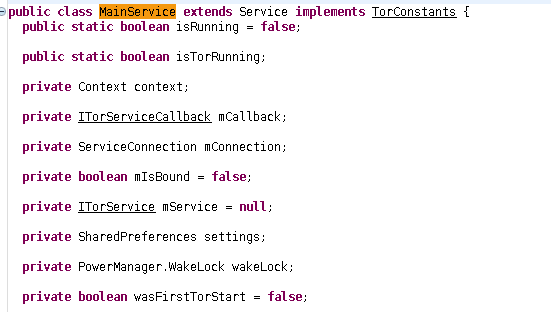
whoa whoa whoaaa. this is scary ryt? we got some tor shit going on here.
Let’s examine, onCreate function.
as we can see, this one creates a ScheduleExecutorService class and calls newSingleThreadScheduledExecutor
ScheduledExecutorService scheduledExecutorService = Executors.newSingleThreadScheduledExecutor();
ScheduleExecutorService is an ExecutorService which can schedule different tasks to run
periodically. This makes sense cause when we first run the malware, we get that ugly windo
w and it was continuasly displayed on the screen periodically until we uninstall the malwa
re.
MainService$3 mainService$3 = new MainService$3();
this(this);
TimeUnit timeUnit = TimeUnit.SECONDS;
scheduledExecutorService.scheduleAtFixedRate(mainService$3, 0L, 180L, timeUnit);
here, onCreate function creates mainService$3 and schedule it to execute repeatedly for
a fixed rate.
Just like the one above, onCreate creates mainService4 and do the same with it.
then..
Thread thread = new Thread();
MainService$5 mainService$5 = new MainService$5();
this(this);
this(mainService$5);
thread.start();
here, onCreate function creates a thread, another service called mainService$5 and start
new service within the newly created thread.
What we know so far⌗
Summurizing what we know so far, first we finds out that this apk cant be decompiled into smali code using apktool. Then we tried with jd-gui and we were successful.
About the code, we found out that Main function calls startService which in turn initialize MainService.
There, MainService initialize MainService$3 && mainService$4 to run periodically. Then it starts another
thread and run MainService$5.
Encryption⌗
Now let’s look at MainService$5.
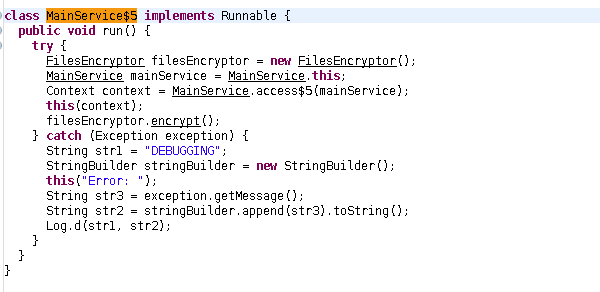
See? we got what we wanted. This is the class that encrypts our files.
First it creates a FilesEncryptor object. Then it calls filesEncryptor.encrypt().
There’s some exception handling too. if the encryption fails, it sets up some debugging
messages and call Log.d
lets take a look at FilesEncryptor class.

ah yes! the files my friend, the files. here we can see the class has two array members, first one for files-to-be-decrypted and second one for the files-to-be-ecrypted.
then there is another member for shared preferences.
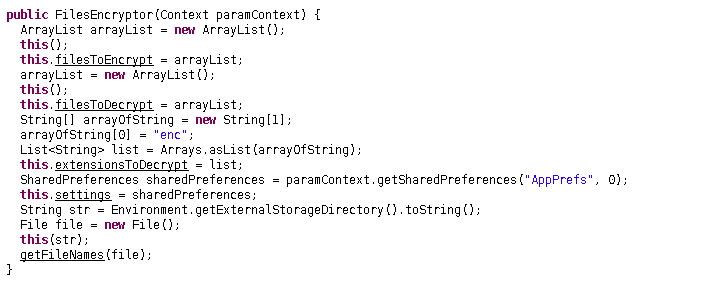
here the function creates an ArrayList and asign it to filesToEncrypt &&
filesToDecrypt we previously saw. next few lines
String[] arrayOfString = new String[1];
arrayOfString[0] = "enc";
List<String> list = Arrays.asList(arrayOfString);
this.extensionsToDecrypt = list;
SharedPreferences sharedPreferences = paramContext.getSharedPreferences("AppPrefs", 0);
this.settings = sharedPreferences;
String str = Environment.getExternalStorageDirectory().toString();
File file = new File();
this(str);
what the above snippet does is, fist it creates a string array and then set 1st element (0) to “enc”. Then the string array is assigned to List<String> list, which then assigned to extensionsToDecrypt. So all above snippet does is, creating assigning a List of extensions so that malware can decrypt only those that it previously encrypted.
then we can see FilesEncryptor calls getFileNames().
Well..Im not gonna take a look at that one cause, all it does is get filenames. And we dont have to give a shit how it does that. However keep in mind that this is the one
that appends filesToEncrypt ArrayList.
Now lets go back to mainService$5. As we saw earlier, this is the function which calls
FilesEncryptor.encrypt().
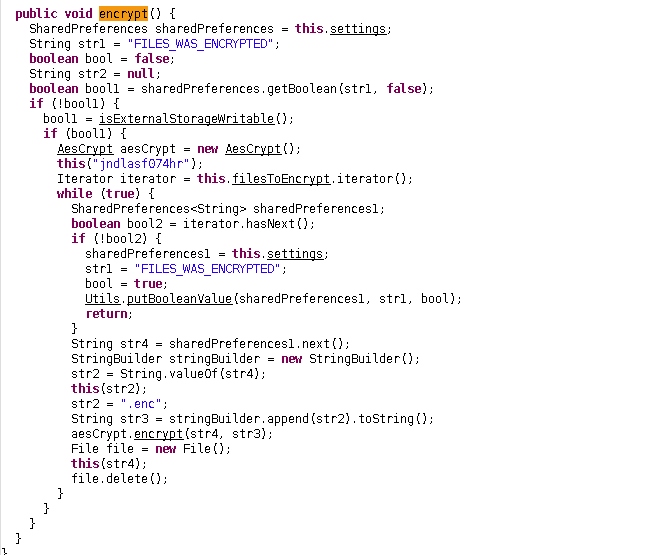
I mean dude, i you got two holes in your face filled with two testical like balls, you can clear see the key and the algorithm. And that’s all you want to decrypt your files.
Anyway, lets analyze this one… first there is an if statement which check if
sharedPreferences contains str1, which is “FILES_WAS_ENCRYPTED”. then the next if
statement checks whether is it possible to write to external storages using
isExternalStorageWritable().
AesCrypt aesCrypt = new AesCrypt();
this("jndlasf074hr");
then we can see above snippet, which initialize an AesCrypt object and pass the key
jndlasf074hr.
then it creates an iterator to filesToEncrypt and iterates through each file.
in the loop, if current one does not have a next, function sets sharedPreferences to
“FILES_WAS_ENCRYPTED”.
str2 = ".enc";
String str3 = stringBuilder.append(str2).toString();
aesCrypt.encrypt(str4, str3);
File file = new File();
this(str4);
file.delete();
Again, a string is assigned with “.enc”. Now this looks like an extension too. So my guess previous one is for folders/directories and this one is for files.
then str3 is assigned with a string with str2 appended and is passed to aesCrypt.encrypt() function alongside with str4
String str4 = sharedPreferences1.next();
which is shown in the above snippet.
then a new file is created passing str4 as the argument and then deleted.
So this one is basically a loop that encrypts every file that is specified in the
filesToEncrypt ArrayList and deletes the original one.
Cool. Now we have dissected the encryption part. Now lets take a look at decryption part.
Decryption⌗
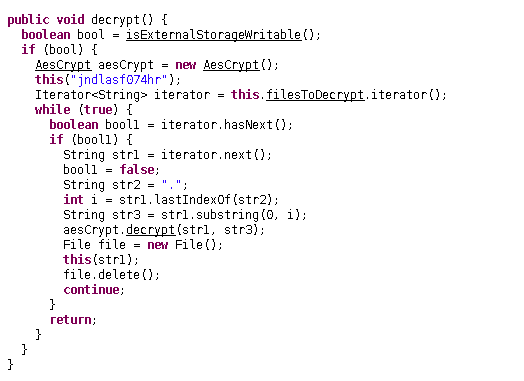
Since we have already analyzed main parts of the code, this is going to be easy.
Just like the encrypt, this one too, check whether external storagesis writable. if true, an AesCrypt object is constructed and passed
the key as an argument.
oh yeah an iterator is also created.
then there is a while loop, which again checks whether if iterator.hasNext() is true. if true, str1 is assigned with iterator.next() and str2 is with “.”.
then we have int i, which is initialized with str1.substring(0, i)
both are then passed to aesCrypt.decrypt() function to decrypt the
file.
then the file named with str1 is deleted and loop continued.
Now, that’s all we need to decrypt the files!!!. However feel free to take a look at AesCrypt if you want.
Other stuff⌗
Since we are done with the encryption part, let’s see what does this thing do with tor. First of all, goal here is not to dissect everything but to find anything useful for host-based / network signatures.
So what looks juicy for me is Constants.class
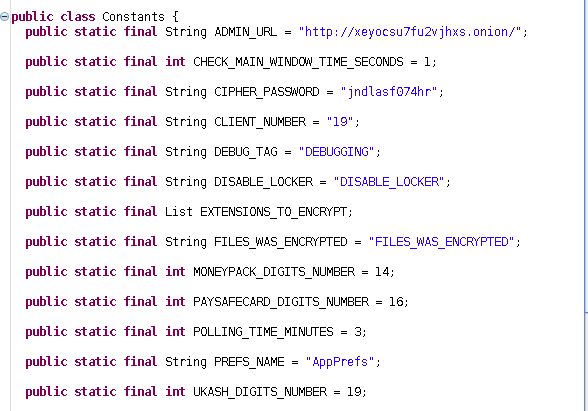
Holy shit. i should have analyzed this one before the other functions. this one gives us the key in plain.
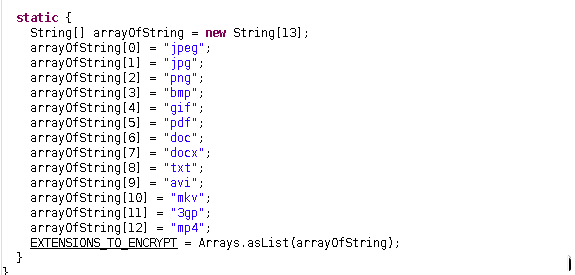
see? we got the file extensions that this ransomware encrypts (if you
have analyzed getFileNames, this must be familiar to you…
Now pay your attention to the first constant defined in the class ADMIN_URL. This sounds
like a CnC server address. this is a good network based indicator.
http://xeyocsu7fu2vjhxs.onion/.
Writing a decrypter⌗
Since we know how the ecnryption and decryption works, we can write an app that can decrypt all the files. I’ll leave a snippet down below and you can copy it to android studio.
package com.example.decrypter;
import androidx.appcompat.app.AppCompatActivity;
import android.content.SharedPreferences;
import android.os.Bundle;
import android.os.Environment;
import android.view.View;
import java.io.File;
import java.io.IOException;
import java.io.UnsupportedEncodingException;
import java.security.InvalidAlgorithmParameterException;
import java.security.InvalidKeyException;
import java.security.NoSuchAlgorithmException;
import java.util.ArrayList;
import java.util.Arrays;
import java.util.Iterator;
import java.util.List;
import javax.crypto.NoSuchPaddingException;
public class MainActivity extends AppCompatActivity {
private ArrayList filesToDecrypt;
private List<String> extensionsToDecrypt;
@Override
protected void onCreate(Bundle savedInstanceState) {
super.onCreate(savedInstanceState);
setContentView(R.layout.activity_main);
}
public void onClick(View view) {
this.filesToDecrypt = new ArrayList();
String[] arrayOfString = new String[1];
arrayOfString[0] = "enc";
this.extensionsToDecrypt = Arrays.asList(arrayOfString);
File file = new File(Environment.getExternalStorageDirectory().toString());
getFileNames(file);
try {
decrypt();
} catch (NoSuchPaddingException e) {
e.printStackTrace();
} catch (NoSuchAlgorithmException e) {
e.printStackTrace();
} catch (IOException e) {
e.printStackTrace();
} catch (InvalidAlgorithmParameterException e) {
e.printStackTrace();
} catch (InvalidKeyException e) {
e.printStackTrace();
}
}
private void getFileNames(File paramFile) {
File[] arrayOfFile = paramFile.listFiles();
for (int i = 0;; i++) {
int k = arrayOfFile.length;
if (i >= k)
return;
String absolutePath = paramFile.getAbsolutePath();
String fileName = arrayOfFile[i].getName();
File file = new File(absolutePath, fileName);
boolean isDirectory = file.isDirectory();
if (isDirectory) {
File[] arrayOfFile1 = file.listFiles();
if (arrayOfFile1 != null) {
// if a directory, get names of files inside it recursively
getFileNames(file);
continue;
}
}
// if not a directory
String str3 = file.getAbsolutePath();
String subStr = str3.substring(str3.lastIndexOf(".") + 1);
List<String> list = this.extensionsToDecrypt;
// if pathname contains .enc
boolean bool1 = list.contains(subStr);
if (bool1) {
list = this.filesToDecrypt;
fileName = file.getAbsolutePath();
list.add(fileName);
}
continue;
}
}
private boolean isExternalStorageWritable() {
String ext = Environment.getExternalStorageState();
String mounted = "mounted";
boolean isMounted = mounted.equals(ext);
if (isMounted)
return true;
isMounted = false;
mounted = null;
return isMounted;
}
public void decrypt() throws NoSuchPaddingException, NoSuchAlgorithmException, IOException, InvalidAlgorithmParameterException, InvalidKeyException {
boolean isWritable = isExternalStorageWritable();
if (isWritable) {
AesCrypt aesCrypt = new AesCrypt("jndlasf074hr");
Iterator<String> iterator = this.filesToDecrypt.iterator();
while (true) {
boolean hasNext = iterator.hasNext();
if (hasNext) {
String inputFileName = iterator.next();
hasNext = false;
int i = inputFileName.lastIndexOf(".");
String outputFileName = inputFileName.substring(0, i);
aesCrypt.decrypt(inputFileName, outputFileName);
File file = new File(inputFileName);
file.delete();
continue;
}
return;
}
}
}
}
oh and just copy the contents of the AesCrypt.class from jd-gui. then build it and install the app on the android VM.
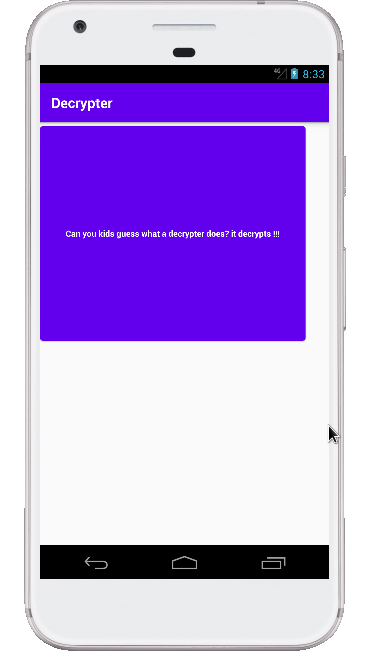
yae yae ik. Im not a UI designer or an android developer.
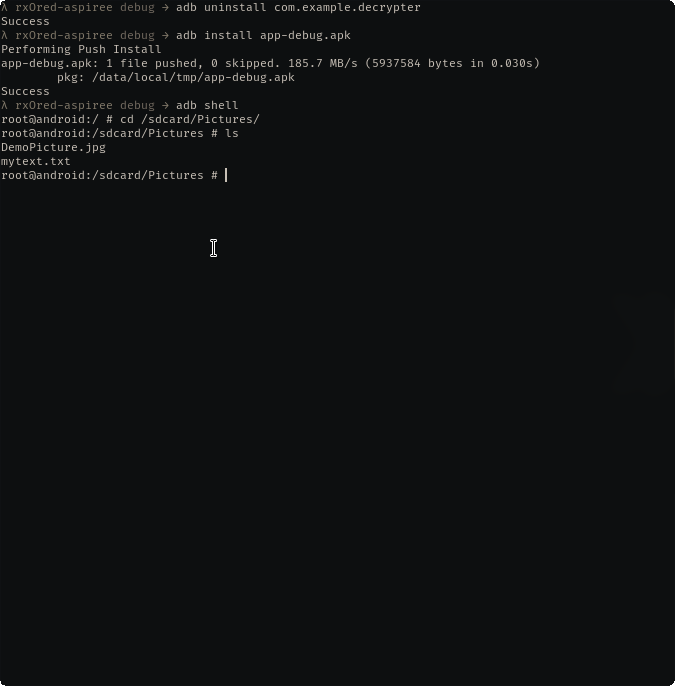
The end⌗
So yeah i think that’s it.
#Speard Anarchy!